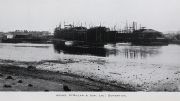Archibald McMillan and Sons
Archibald McMillan and Sons of Dumbarton were shipbuilders
1834 Archibald McMillan and his son John began shipbuilding in 1834
1838 they moved to larger premises on the north bank which enabled them to scale-up production.
1846 they acquired the premises known as the Dockyard (previously occupied by James MacAlister), containing one of the oldest dry-docks on the Clyde, which the firm enlarged.
1854 Archibald McMillan died
1860s The yard mainly made small wooden barques before building sugar traders and then iron sailing ships.
1865 See 1865 Clyde Shipbuilders for detail of the tonnage produced
1867 John McMillan, Senior extended the yard by purchasing more land.
1868 John brought his sons, Robert and John, into the Company
1868 Built the largest sailing ship of its day - the Peter Stuart
1873 Again built the largest sailing ship of its day - the Thomasina MacLellan
1874 Again built the largest sailing ship of its day - the Stuart Hahneman
1877 Launched SS Grangemouth. [1]
1880s The yard began to specialise in steel steamers and sailing ships for British and German companies.
1888 Glasgow Exhibition. Description of their exhibits in The Engineer [2]
1888 On the death of John junior, his brother James McMillan was brought into the company
1889 See 1889 Shipbuilding Statistics for detail of the tonnage produced
1890 Took limited company status. 'very old established business' [3]
1901 There was a fire at the yard which caused serious damage to many of the yard's buildings.
1911 Robert Macmillan died and his eldest son William Macleod Macmillan took over.
WWI The yard built "Flower" class sloops, paddle minesweepers and small feet oilers for the Admiralty. William Macleod Macmillan was killed during the War serving in France. He was succeeded by James Macmilan. During the war the yard also built four "A" and "B" type tramps, one "AO" tanker and a standard coaster for the Shipping Controller.
1916 Owen Philipps and William Pirrie acquired the yard through the Lamport and Holt company which passed the management to Harland and Wolff.
1915-1930 The yard began making tankers for a number of companies including Lamport and Holt.
1918 Lamport and Holt bought a controlling interest in the yard [4].
From 1919-30 the yard, which had been modernised and expanded, involving significant investment, made 23 further ships. However, each ship returned smaller and smaller profits and eventually the yard closed in March 1930.
1932 The yard was purchased by National Shipbuilders Security in April.
1937 The yard was demolished and the site was redeveloped for other uses.
See Also
Sources of Information
- ↑ The Engineer 1877/09/14
- ↑ The Engineer 1888/05/11 p389
- ↑ The Engineer 1890/02/28 1890 p171
- ↑ The Times, 12 April 1918
- L. A. Ritchie, The Shipbuilding Industry: A Guide to Historical Records (1992)
- British Shipbuilding Yards. 3 vols by Norman L. Middlemiss


